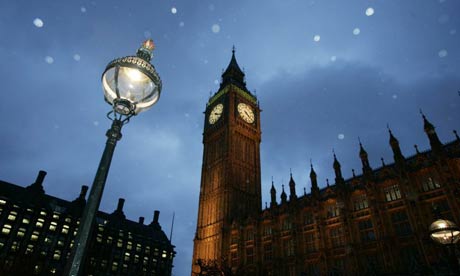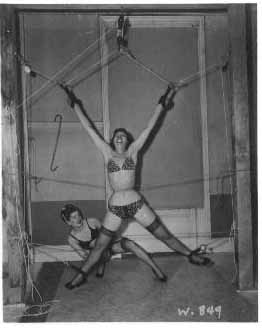You have to wonder, what with the snow and windchill and the snow and the windchill.
It's not really that much snow--somewhere between five and ten centimetres. But this
is Victoria, so the city pretty much shut down yesterday.

About 10:30 am we were walking over to the in-law's place for Sunday brunch. Lila was leaving for Edmonton (and,
snicker, -30ºC) and this was going to be Christmas brunch for the 5 of us.

I thought it was kind of pretty--even if it was bringing back too many memories of Alberta. What's worse, though, is that Greater Victoria doesn't really have a lot in the way of snow removal experience--or snow removal equipment, for that matter. though things have improved since the Great Snow of 1998 (no, seriously. A metre of wet, heavy snow fell overnight. Cars disappeared. It really
was insane).
We had brunch with the folks, and Lila eventually made her way over (Sunday transit service and very slippery streets
do add up to a certain amount of traffic tie-ups). I picked up the
Victoria Car Share pickup we'd reserved, and picked her and Paula up for the trip to the airport. It took ten or so tries, but I eventually got out of the parking lot at the condo. Not much of a rise, but the snow that had fallen was very wet (typical here on the West Coast) and when the temperature stayed below zero, the water--particularly where the snow had been driven on) began to freeze. Quite different from the much drier snow of Alberta.
The trip to the airport was uneventful, except for the fact that on the highway people were actually driving at the speed limit or below. Anyone who's driven out to the airport or ferry knows just how unusual
that is!
Lila went through security into the
holding cell boarding area, and Paula and I returned to the city--again at or below the speed limit. We picked up groceries (stuff in volume, like rice, that I didn't want to carry the 3 km home on my back), and then I dropped off the truck.
The 3km walk back to the house was not too bad. It would have been better had I been able to find my toque or fleece hat, but
nooo. Trip over them every friggin' day, but when it snows? Gone.

Seriously, McKenzie Ave by UVic looks like any winter scene in Edmonton--especially if you could see the blowing snow in this shot. the only difference is that Edmonton is usually sunnier than Victoria was yesterday.
Walking down from the university, where McKenzie turns into Sinclair Hill, you could catch glimpses of Mt. Baker.

I pointed it out to a couple that came up while I was taking the photograph, and they stopped, suprised, to look at the mountain glowing through the trees. "What, you can
see Baker from here?!" "Sure can." As we looked, another couple of girls stopped, somewhat suprised to see the mountain. Do people never look around them as they walk? Sure it was icy and you did have to pay attention, but this was four people suprised to see a mountain that I look for pretty much every trip down the hill.
When I got back to the house, Paula and I went out on the beach. I wanted to find a set of stairs off the beach I'd found (from the top) the other day.

The beach didn't look normal. Something was subtly different. Not the driftwood or logs, not the trees. Hmm. Oh, the way Paula is dressed! No wetsuit!

Great Chain looked a bit different too, and not just because of the perigeal tide. Somehow it showed up better across the water, reflecting more light.

But I'm not kidding about someone overfilling the ocean. this is a bit past high tide, and a day past the highest tide of the weekend, but even so, the water's been washing over the gravel you see, and up to the snow line. That's a lot of water. Oh, and you can see the snow blowing through the park (centre-left).
I did find the bottom of the stairs.

Hard to imagine that I've consistently missed them. I've seen them a couple of times, but they keep falling off my mental map of the area. So this time I climbed them.

It's a darned nice view. Not the usual look I get at Cadboro Bay. The boats at the mooring buoys by the yacht club are clearly laid out in rows, not randomly as they appear from the beach or water.
While Paula and I were walking through the uncharacteristic snow and below zero temperatures, we spotted something in the water.

Yup, that's a kayak. Didn't look like one at first, but once we saw the red of the upper deck, it was pretty clear. This was a kayak in trouble. And, if you know us, that's just going to be the beginning of the story.

It was late, getting dark, and cold. The fastest way to get this kayak salvaged was for Paula to go out in her Dragonfly. She got changed, and I carried her boat down to the water through the (very cold, very strong) wind, and she prepped her lines. I don't fit in the Dragonfly (that's my excuse and I'm sticking to it!), so it would be up to Paula to get a line onto the bow of the sunken boat.

After some struggles with the wind and line, Paula got attached and hauled the other end back to me on the shore (it's true, I'm the muscle, she's the brains). It took a little while, and the sky kept getting darker while the wind kept a-blowin'. Thankfully it wasn't kicking up too much chop--the wind was coming more from the north, which doesn't let it get too frisky with the water in Cadboro Bay. Eventually, I got my hands on the line and slowly dragged the sunken kayak into shore.

Brutally heavy, filled with water, it took quite a while to get it up on the beach. It didn't help that once the water was out, I was still trying to move a boat with 20 kilos of wet sand in it.
We tied the boat off to a log--hoping the wind doesn't shift while the tide is still in--so it doesn't get pulled back out. I wasn't in a real hurry to haul it back to the house, and there's a reason for that.

Yeah, the bottom is badly damaged in at least three places. Once the cold weather settles down (probably not tomorrow), I'll head back down to it and see if I want to repair it. Or maybe just salvage the skeg setup out of it. I wouldn't complain about another kayak in the quiver, but I have to guard against having for the sake of having--after all, that's how I got our latest kayak....
We heard from Lila after dropping her at the airport; her flight to Vancouver had been cancelled. Air Canada finally flew her over about 7:00 pm and she was shunted onto a 10:30 pm flight to Edmonton. From what we've heard, the incomparable Quinn picked her up at Edmonton International after 1:00 am--when he had work that morning at 6:00am. It is true, we know the
best people.
Powered by ScribeFire.















































